X-ray reflectmetory of lubricant
Inquiry number
SOL-0000000878
Beamline
BL19B2 (X-ray Diffraction and Scattering II)
Scientific keywords
| A. Sample category | organic material |
|---|---|
| B. Sample category (detail) | macromolecule, membrane |
| C. Technique | X-ray elastic scattering |
| D. Technique (detail) | reflection, refraction |
| E. Particular condition | room temperature |
| F. Photon energy | X-ray (4-40 keV) |
| G. Target information | structure analysis |
Industrial keywords
| level 1---Application area | storage device, Chemical product |
|---|---|
| level 2---Target | HD,MO |
| level 3---Target (detail) | film, lubricant |
| level 4---Obtainable information | density, film thickness |
| level 5---Technique | reflectometry |
Classification
A80.10 electronics, M10.50 reflectometry
Body text
In this solution, X-ray reflectometry was applied to lubricant to analyze its film thickness. X-ray reflectometry is powerful technique to characterize very thin film. These data reveal the fact that the thickness of the lubricant is determined to be 0.7 nm.
Observed reflectivities of lubricant on Si substrate (blue curve) and Si substrate (brown curve)
Source of the figure
Private communication/others
Description
広沢作成(試料は松村石油 坂根氏)
Technique
X-ray reflectometry is performed by observing X-ray reflectivity from sample. X-ray reflectivity is affected by thickness of films, electron densities of films and substrate, and roughness at surface and interfaces. In this solution, thicknesses and electron densities of coated lubricant, and native oxide layer of Si substrate were obtained.
Source of the figure
No figure
Required time for experimental setup
1 shift(s)
Instruments
| Instrument | Purpose | Performance |
|---|---|---|
| Multi-axis diffractometer | diffraction | 4axes and 2axes |
References
| Document name |
|---|
| S. Pershan&A. Nielsen., Phys. Rev. Lett. 52,759 (1984) |
Related experimental techniques
Questionnaire
This solution is an application of a main instrument of the beamline.
Ease of measurement
Easy
Ease of analysis
Middle
How many shifts were needed for taking whole data in the figure?
Less than one shift

